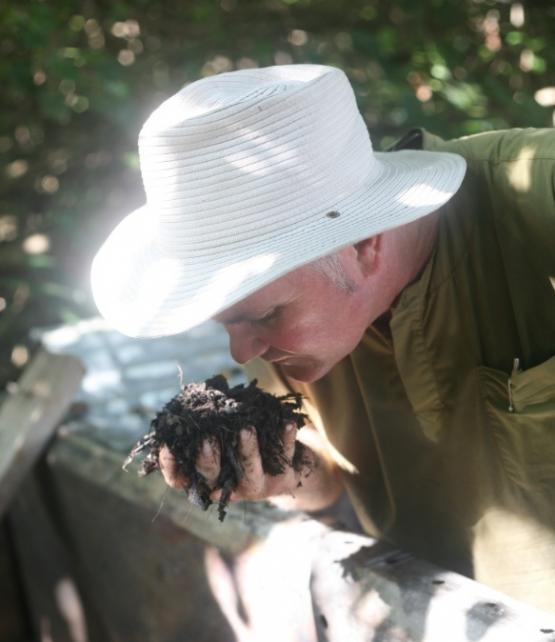
Understanding Soil
7 min read
By Mark Garrett
“You are what you eat”. The truth of this saying is becoming ever more evident with the rising numbers of people worldwide affected by food related diseases such as diabetes, obesity and environmental toxicity.
But did you know that what you eat is only as healthy as the soil in which it grows? We need oxygen, water and carbon to live, and so does soil. If these basic compounds are missing then the plants growing in the soil will not receive the full range of nutrients (nitrogen, potassium, phosphorous, sulphur, calcium, magnesium) and trace elements (iron, zinc, copper, selenium, boron, molybdenum, cobalt) for healthy growth, consequently neither will we if we eat them. Simple, isn’t it?
Given this causality, it would seem pretty self-evident that if you want to be healthy, then eat and drink foodstuffs derived from healthy plants on healthy soil. This alone is as good a reason as any to use permaculture principles for sustainable agricultural production!
The question, is how do you create healthy soil?
What is soil?
Soil is made up of humus, minerals, soil biota, gases, water and gels. We cannot have one with out the other for healthy soil. The short version is. Humus holds water and gels another water reserve plus minerals. Biota make humus and alter soil structure for water and gasses to enter soil from the atmosphere. Plants absorb this life supply of nutrients and minerals through their roots and this is how the earth breathes. Simple now for a longer explanation.
Humus content can account for as little as 2% or as much as nearly 100% of soil composition. Compost fed or mulched gardens generally have up to up to 40 % or more. Humus can only be provided by roots and above ground biomass (grasses, trees and other plants). Having adequate soil humus allows for effective water retention.
Water as described by Bill Mollison “is a soup of free living organisms dissolved gases, salts, mineralsand gels. Gels are reserves for water.
The by-products of humus include minerals from the biomass, which are freely available and biologically active for plant uptake. Mulching adds plant nutrients, minerals, regulates soil temperature, and promotes soil life and erosion control.
Soil life or biota consists of fungi, bacteria, yeasts, algae, protozoan’s and larger fauna (earth worms, nematodes, arthropods, mollusc fauna). The biota working together are the humus factory that is the soil food web or the canteen supplying food (nutrients) for the soil. They create tunnels and improve soil structure to bring gases (oxygen, nitrogen) and water into the land that is then up taken by plant roots. This exchange of gases from the atmosphere to the soil and soil to atmosphere is how the earth breathes.
Our friends release minerals and nutrients through their exoskeleton when they die and secrete nutrients while munching away on the carbon and nitrogen you have supplied to them.
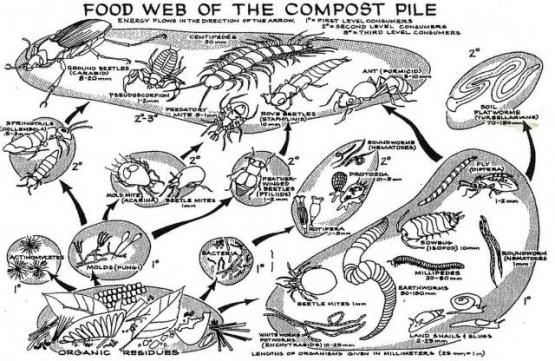
So if you want to increase your humus content, if you want your soil to be healthier and more nutritious, you need more workers in your factory. You need more soil life. Left entirely up to nature, growing topsoil can take a while. In fact, it can take up to 500 years to grow 1 inch of topsoil. How come? Because if you don’t have the right environment for the biota to live in, you can have all the biomass in the world and it will never turn into useable humus. The key is a lots and lots of biota.
If you provide a balanced diet, and help the biota flourish, you can create humus in a fraction of the time. I do this using a composting method called “Hot Composting or the Berkeley Method”, (check out the 18 day recipe that I use in my next blog post “Growing Soil”, coming out on the 12 April).
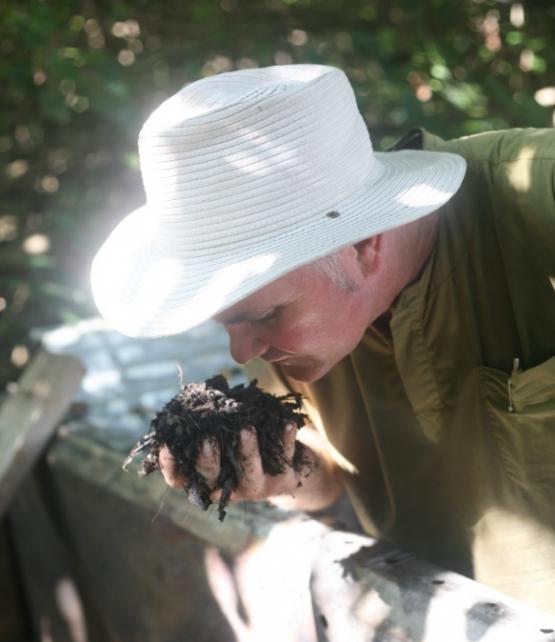
The humus you create can then be used to feed the soil, which is essential since it is soil that feeds plants, not us. Healthy soil, healthy plants!
Other ways to feed soil beside using mulch (again more information on this in my next blog) and making compost is by growing legumes and green manure from seed. (Your climate will determine what you can use – in the tropics, for example, I had success with mung bean, cow pea, millet and buckwheat to name a few). Once grown, these plants will then supply biomass (carbon) and nitrogen. They will also retain moisture, cool the ground by reducing evaporation, and prevent weed growth. When they then come to seed, these can be collected for food or can be sown again to start again. This is a great example of permaculture design principles in action: “each element should perform multiple functions”; “use and accelerate natural plant succession to establish favourable soils and sites” & “encourage polyculture and diversity to benefit species for productive, interactive systems” (see my blog on What is Permaculture? for more information).
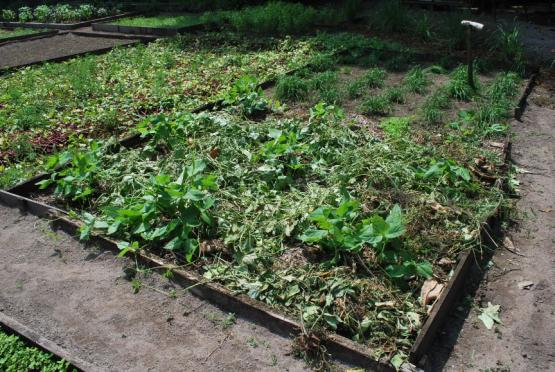
The importance of pH
Soil pH influences the availability of nutrient and trace element uptake by plants. I always take soil pH readings whenever doing a site analysis, as this is a key indicator of what the soil requires to repair it or to sustain it.
To grow vegetables, fruits, herbs and spices for instance, a soil pH ranging from 6.5 to 7.5 is ideal. A soil pH in this range allows for minerals, trace elements to become available to the plant at the correct stages of plant development. This then enables the plant to build immunity against pest and disease. pH levels at the other end of the scale will not allow the plant to get what it needs when it needs it; this is not saying the nutrients and elements are not in the soil just unavailable to the plant.
Fortunately as a permaculturist our life is made simple as nature adjusts soil pH simply through organic matter!! Yes no matter what soil type you have or what pH range you have, if you don’t have evidence of healthy plants, soil life or good soil composition, throw organic matter down and in time your pH will adjust towards neutral.
When I arrived in the Maldives, for example, the garden soil pH was 8-9 Alkaline and was pretty much devoid of life. The soil was sandy, exposed to the sun, wind and rain, and only fertilized with cow dung imported from India. And meanwhile, our restaurants on the island were producing about 1 ton of food waste a day that was simply being dumped in the sea! It was criminal! We turned this on its head and using coconuts, jungle trimmings and charcoal, all collected on the island, plus a handy shredder machine, within just 3 months we had the soil pH down to 7 and the gardens became more productive. It is literally possible to drop 1 pH point a month if you put your mind to it.
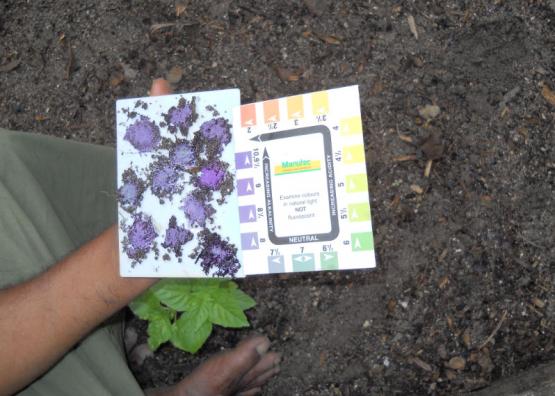
Healthy soil, lots of life. Lots of life, fewer pests…
Again, as with humus creation and balancing pH, biodiversity is your ally as you can help guarantee your food/crop security by introducing predators that help with pest management. This can be done through thoughtful plant selection.
A good bug mix of seed scattered on the edges of the beds or in-between crops, for example, will encourage pollinators and predators into your garden by providing habitat and food for ‘beneficial’ insects (e.g. predatory mites, tiny micro wasps, ladybirds, lacewings, hoverflies, tachnid flies or predatory beetles). These beneficial insects or ‘good bugs’ are generally small with correspondingly small mouthparts, so they are only able to feed on particular flowers with suitable attributes – which means your crop is safe! And if you provide a plentiful food supply, then the ‘good bugs’ will live longer and reproduce, keeping your pests at bay for longer still. Marigolds can fumigate the soil against nematodes too. This is sustainable pest control.
Again depending on your climate a good bug seed mix can include red clover, alyssum, cosmos, marigolds, Queen Anne’s Lace, buckwheat, Lucerne, dill, caraway, coriander, phacelia and gypsophila. (Check out greenharvest.com for lots more useful information on biological pest management).
To sum up
It all starts with your soil. Once you have a healthy soil with a good humus content and increased soil life, you can then grow healthy plants that protect themselves from pests and disease. The world beneath our feet needs care and consideration if we want healthy plants producing us healthy food & drink. Just as we need the right diet to be healthy so does the soil and once we understand the fact that you can only feed soil by creating an environment that welcomes soil life, then we’re on the path to success.
If you have any questions, post your comments below and I will get back to you. Alternatively you can get hold of me on Twitter (@MGpermaculture) or by email.
- For the publishing schedule of Mark’s blog series, see “Our Virtual Expert“
- To read blog 1 in Mark’s series, see “What is Permaculture?“
- To read blog 2 in Mark’s series, see “Permaculture Design“


